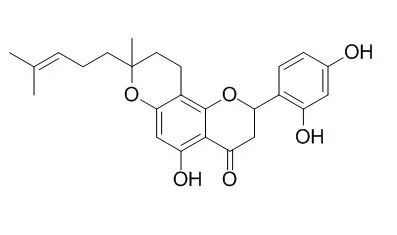| In vitro: |
| Arch Pharm Res. 2015 Nov;38(11):2066-75. | | Isoprenylated flavonoids from the root bark of Morus alba and their hepatoprotective and neuroprotective activities.[Pubmed: 25981820] |
A new isoprenylated flavonoid, 2S-5,7,2',4'-tetrahydroxy-3',5'-di-(γ,γ-dimethylallyl)flavanone, sanggenol Q (1), along with seven known isoprenylated flavonoids, sanggenol A (2), Sanggenol L (3), kuwanon T (4), cyclomorusin (5), sanggenon F (6), sanggenol O (7), and sanggenon N (8), three known Diels-Alder type adducts, sanggenon G (9), mulberrofuran G (10), and mulberrofuran C (11), and a known benzofuran, moracin E (12), were isolated from the root bark of Morus alba using silica gel, ODS, and Sephadex LH-20 column chromatography.
METHODS AND RESULTS:
Chemical structures were determined based on spectroscopic data analyses including NMR, MS, CD, and IR. For the first time, compounds 1 and 7 were isolated from the root bark of M. alba. All compounds were evaluated for hepatoprotective activity on t-BHP-induced oxidative stress in HepG2 cells and neuroprotective activity on glutamate-induced cell death in HT22 cells. Compounds 1, 4, 8, 10, and 11 showed protective effects on t-BHP-induced oxidative stress with EC50 values of 6.94 ± 0.38, 30.32 ± 6.82, 23.45 ± 4.72, 15.31 ± 2.21, and 0.41 ± 0.48 μM, respectively, and compounds 1, 2, 10, 11, and 12 showed protective effects on glutamate-induced cell death with EC50 values of 5.54 ± 0.86, 34.03 ± 7.71, 19.71 ± 0.71, 16.50 ± 7.82, and 1.02 ± 0.13 μM, respectively. | | J Nat Prod. 2001 Feb;64(2):181-8. | | Cytotoxic flavonoids with isoprenoid groups from Morus mongolica.[Pubmed: 11429996] | A new pyranoflavanone, Sanggenol L (1), a Diels-Alder type adduct regarded as a cycloaddition product of a dehydrogeranylflavanone and a prenylchalcone, sanggenol M (2), along with four new 2-arylbenzofurans with isoprenoid units, mulberrofurans W-Z (3-6), were isolated together with 10 known flavonoids from Chinese Morus mongolica.
METHODS AND RESULTS:
The structures of these novel compounds were elucidated by spectroscopic methods. All flavanones investigated here showed higher cytotoxicity against human oral tumor cell lines (HSC-2 and HSG) than against normal human gingival fibroblasts (HGF). Among them, the cytotoxicity of compound 2 and the Diels-Alder type flavanone sanggenon C (7) isolated from Morus cathayana were the most potent. On the other hand, seven 2-arylbenzofurans exhibited lower cytotoxicity and tumor specificity as compared with flavanones. |
|






 Cell. 2018 Jan 11;172(1-2):249-261.e12. doi: 10.1016/j.cell.2017.12.019.IF=36.216(2019)
Cell. 2018 Jan 11;172(1-2):249-261.e12. doi: 10.1016/j.cell.2017.12.019.IF=36.216(2019) Cell Metab. 2020 Mar 3;31(3):534-548.e5. doi: 10.1016/j.cmet.2020.01.002.IF=22.415(2019)
Cell Metab. 2020 Mar 3;31(3):534-548.e5. doi: 10.1016/j.cmet.2020.01.002.IF=22.415(2019) Mol Cell. 2017 Nov 16;68(4):673-685.e6. doi: 10.1016/j.molcel.2017.10.022.IF=14.548(2019)
Mol Cell. 2017 Nov 16;68(4):673-685.e6. doi: 10.1016/j.molcel.2017.10.022.IF=14.548(2019)